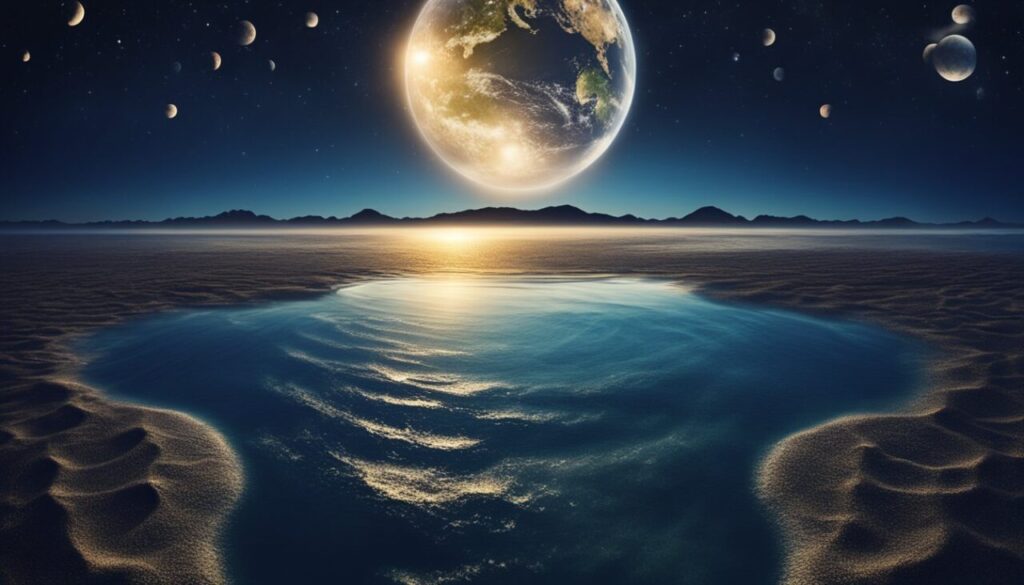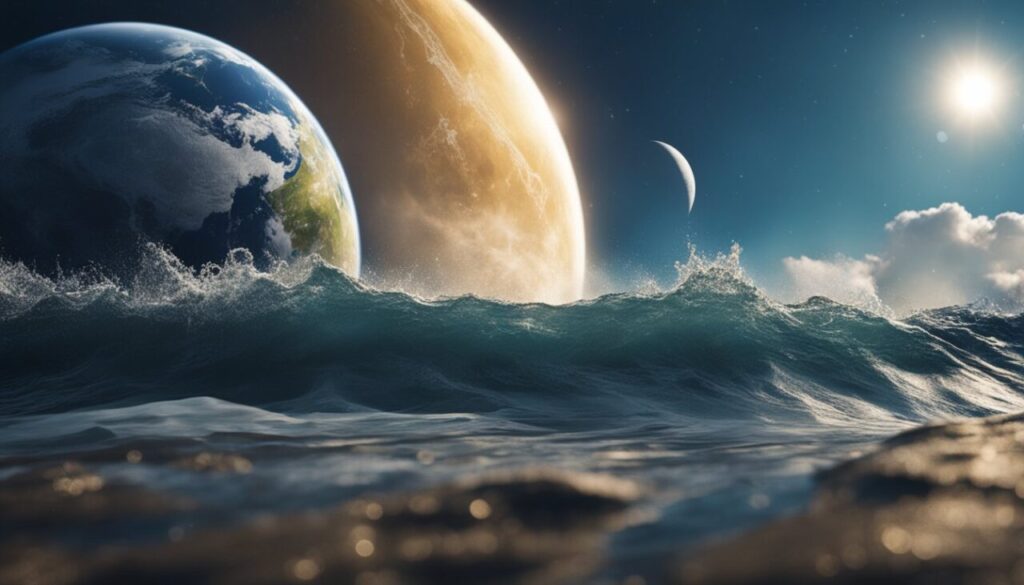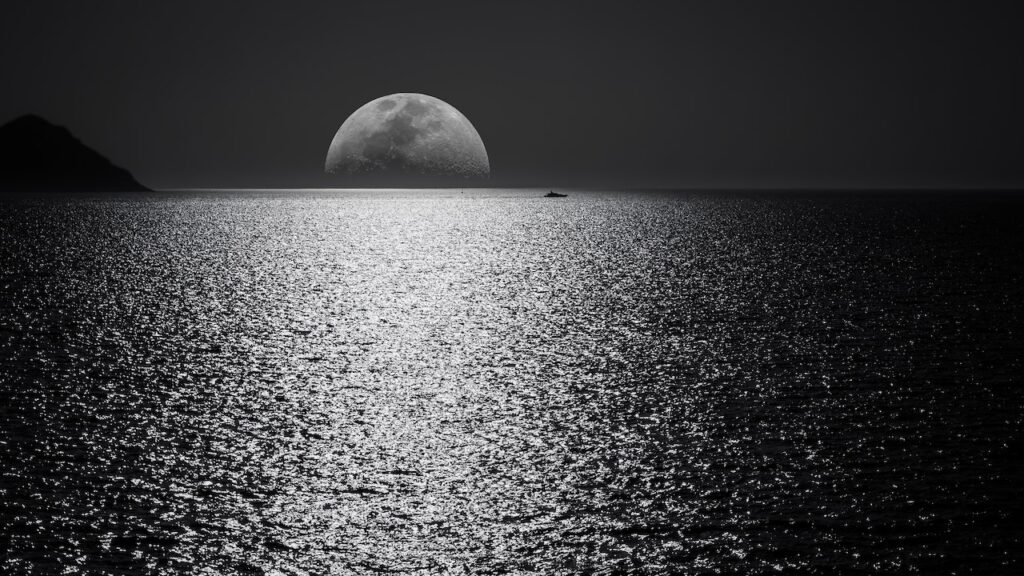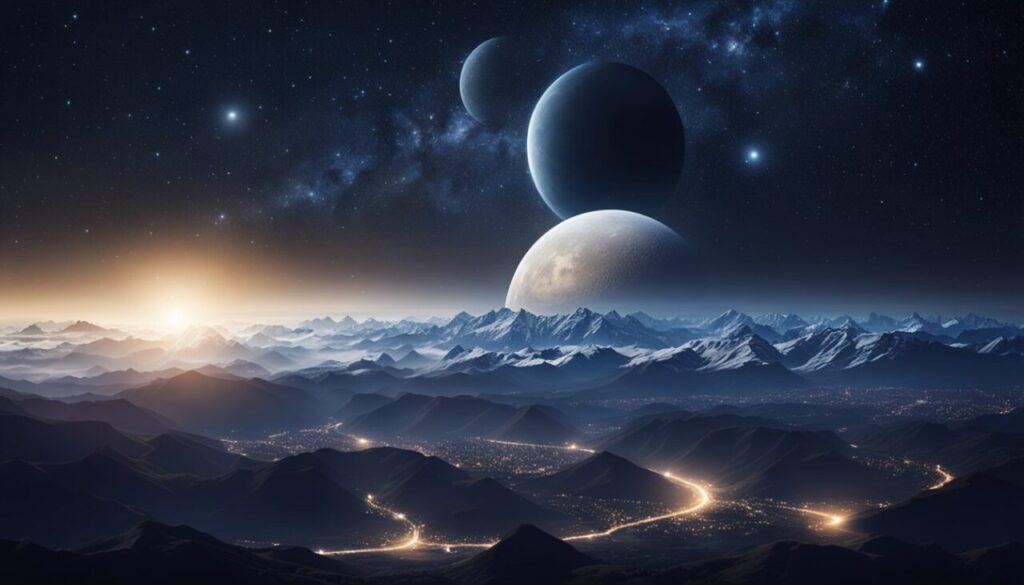
According to scientists, Earth could have had two moons in the past, but it is unlikely to happen again in the future. The idea of having two moons is a rather interesting one and it has been a popular topic not only in science fiction but also in science.
Additionally, it is certainly a popular topic when people have too much to drink as they really believe they see two moons.
Joking aside, it would be rather interesting to explore this thought experiment – what would really happen if Earth had two moons? Would it change our planet completely?
Let’s explore the possible impact on climate, tides, and life on Earth while also thinking about the real possibility of having two moons in the future.
The Physics of Two Moons would have a significant impact on Earth’s tides and gravitational pull. If Earth had two moons, the gravitational pull would be much stronger, and the tides would be much higher.
Neil Comins, a physics professor at the University of Maine, explains that the two moons would create a complex pattern of tides, which could cause flooding in low-lying areas. Additionally, the two moons would affect the Earth’s rotation, making days shorter and nights longer.
Related:
Key Takeaways
1. Having two moons would significantly impact Earth’s tides and gravitational pull, causing flooding in low-lying areas and affecting the Earth’s rotation.
2. The chances of Earth having two moons in the future are very low, but it could be the result of a collision or a captured asteroid.
3. The Moon was formed when a Mars-sized object collided with Earth over 4.5 billion years ago, but scientists are still unsure about how it actually happened.
The Physics of Two Moons

The gravitational force of the two moons would interact with each other and with Earth, leading to complex tidal patterns. The two moons would also interact with Earth’s rotation, causing changes in the planet’s axial tilt and rotation rate.
According to a study, if Earth had two moons of equal size, they would eventually collide due to their gravitational interaction. However, if one of the moons was significantly smaller, it could orbit Earth in a stable manner.
The presence of two moons would also affect the planet’s ecosystem. The additional gravitational pull would cause stronger tides, which could impact marine life and coastal habitats. The gravitational pull of the moons could also affect the migration patterns of animals and the growth of plants.
And while some researchers are proposing that Earth once had two moons, our main interest here is to see if we could potentially have two moons in the future.
Or even better – do we already have a second moon?
Related: What Would Happen If The Moon Exploded
Future Second Moon – Quasi Moon
In 2023, astronomers discovered an asteroid that orbits the sun in a time frame similar to that of Earth’s. This asteroid, named 2023 FW13, is considered a “quasi-moon” or “quasi-satellite” because it circles around Earth while being slightly influenced by our planet’s gravitational pull.
Despite being only about 50 feet (15 meters) in diameter and located at a distance of about nine million miles (14 million kilometers) from Earth, 2023 FW13 has been tagging along with our planet since at least 100 BCE and will most likely continue to do so until around 3,700 CE.
As for the hypothetical scenario of Earth having two moons, experts believe that it would cause chaos on our planet. According to HowStuffWorks, the second moon, named Lluna, would eventually settle into an orbit halfway between Earth and our current moon, causing extreme tides and potentially catastrophic collisions with Earth.
So let’s continue with this hypothetical scenario, delving deeper into the consequences we’ve already mentioned – The impact on tidal systems on Earth.
Related: Top 5 Most Distant Spacecraft In Space
Two Moons and Impacts on Earth’s Tidal System

Oceanic Changes
If the Earth had two moons, the oceanic tides would be much more complex. The gravitational pull of two moons would create more varied and unpredictable tidal patterns. The two moons would create a complex pattern of tides that would make it difficult for marine life to adapt. The tides could become so extreme that they could cause mass extinctions of marine life.
Geological Shifts
In addition to the changes in oceanic tides, the Earth’s geological activity would also be affected. The gravitational pull of two moons would cause more intense tectonic activity, resulting in more frequent earthquakes and volcanic eruptions. Worldbuilding Stack Exchange explains that “the multiple moons would interact with each other to create complex gravitational forces that would affect the Earth’s crust.” This could result in the formation of new land masses or the destruction of existing ones.
Moon Effects on Night Sky

If Earth had two moons, the night sky would look quite different from what we are used to seeing. The two moons would appear to be of different sizes, with the larger one appearing about half the size of the Moon we see today.
It would be an interesting sight to see for sure.
However, would there still be people disbelieving the existence of the moon, or moons in this case?
Probably yes 😊
Ok, disregard that.
Continuing to lunar phases.
Two Moons and Lunar Phases
The two moons would also affect the lunar phases we see on Earth. The new moon and full moon phases would occur twice as often, as each moon would have its own cycle of phases. However, the other phases, such as the crescent and gibbous phases, would be less frequent.
Eclipses
The presence of two moons would also increase the frequency of solar and lunar eclipses. According to Neil F. Comins, a physics professor at the University of Maine and author of the book “What If the Earth Had Two Moons,” the two moons would occasionally align with the Sun and Earth, causing a double eclipse. However, this alignment would be rare and would only occur once every few hundred years.
It is important to note that the effects of having two moons on the night sky would also depend on the orbits of the moons. If the two moons were in a stable orbit around Earth, their movements would be predictable and would not cause any major disruptions to Earth’s environment. However, if the moons were in an unstable orbit, they could potentially collide with each other or with Earth, causing catastrophic damage.
Overall, the effects of having two moons on the night sky would be fascinating to observe, but it is not completely clear what kind of impact it would have on life on Earth.
Let’s explore that scenario also.
Implications of Two Moons and the Life on Earth

Evolutionary Consequences
If the Earth had two moons, it is likely that life on Earth would have evolved differently. Again, according to Neil Comins, the tides caused by two moons would be much higher and more unpredictable than the tides caused by one moon.
This would have a significant impact on marine life, which would have to adapt to these new conditions.
In addition, the gravitational pull of two moons could cause changes in the Earth’s rotation and axial tilt, which would have further effects on the climate and the evolution of life on Earth. For example, changes in axial tilt could cause more extreme seasons, which could affect the migration patterns of animals and the growth of plants.
And actually, nobody can predict what would happen with human evolution in the case of two moons. Perhaps, we wouldn’t evolve at all and perhaps we’d have completely different attributes.
Maybe a 3rd eye 😊
Nonetheless, one thing is certain – in the case of two moons – Earth’s climate would change significantly.
Climate Change
The tides caused by two moons would generate more heat, which could affect the ocean currents and the distribution of heat around the globe. This could lead to changes in the climate, including changes in rainfall patterns and the frequency of extreme weather events.
Furthermore, the gravitational pull of two moons could cause changes in the Earth’s orbit, which could affect the amount of sunlight that the Earth receives.
It is important to note that these are all hypothetical scenarios, and it is impossible to know exactly how life on Earth would have evolved if the Earth had two moons. However, based on current scientific understanding, it is clear that the presence of two moons would have had a significant impact on the Earth’s climate and the evolution of life on Earth.
Conclusion – Earth with Two Moons

To sum it up, if Earth had two moons, things would get pretty interesting. Tides would be more complicated, affecting the oceans and weather in new ways. Imagine two moons lighting up the night sky—it would be a cool sight! The gravitational tug-of-war might even mess with our planet’s tilt, changing long-term weather patterns. Overall, having two moons would be a attractive twist that could spark lots of curiosity and wonder.
And so, at the end let’s look at a couple of FAQ’s regarding Earth and 2 Moons and also couple of interesting (and not so known) facts about the moon itself.
Frequently Asked Questions

What would be the gravitational effects of two moons on Earth?
Having two moons would significantly affect Earth’s gravitational field. The gravitational pull of the two moons would cause the tides to become much stronger and more complex. The gravitational pull of the moons would also affect the Earth’s rotation, causing it to slow down.
How would the tides be affected if Earth had two moons?
The presence of two moons would cause the tides to become much stronger and more complex. The two moons would interact with each other and with the Earth’s oceans, creating a more complex tidal pattern.
What would be the impact on Earth’s climate with two moons?
The presence of two moons would have a significant impact on Earth’s climate. The gravitational pull of the moons would cause the Earth’s rotation to slow down, which would affect the distribution of heat around the planet. This could lead to changes in weather patterns and climate.
How would the presence of two moons affect Earth’s rotation?
The gravitational pull of the two moons would cause the Earth’s rotation to slow down. This would affect the length of the day and the distribution of heat around the planet. The presence of two moons would also cause the Earth’s axis to tilt, which could lead to changes in weather patterns and climate.
Would the presence of two moons affect life on Earth?
The presence of two moons would have a significant impact on life on Earth. The changes in tides and climate could affect the distribution of plant and animal species. The changes in weather patterns and climate could also affect human societies and economies.
What would be the visual effect of having two moons in the sky?
The visual effect of having two moons in the sky would be stunning. The two moons would appear to be different sizes and would create a more complex lunar pattern. The presence of two moons would also affect the amount of light reflected by the Earth, which could affect the behavior of nocturnal animals.
How the Actual Moon Came to Be
The Moon is believed to have formed around 4.5 billion years ago, shortly after the formation of the solar system. The most widely accepted theory is that the Moon formed from debris left over after a Mars-sized object collided with the Earth.
A Rocky Phase in the Orbital Period
The presence of two moons is not a new concept. In fact, scientists believe that the Moon may have had a “sister” moon in the past. This second moon may have been destroyed during a period of instability in the Moon’s orbit.
Near Earth Asteroids
There are many Near Earth Asteroids that orbit the Sun and occasionally come close to Earth. While some of these asteroids are classified as “moons” of Earth, they are not true moons in the same way that the Moon is.
Is 2023 FW13 Earth’s Second Moon?
No, 2023 FW13 is not Earth’s second moon. While it is an asteroid that is currently in orbit around Earth, it is not large enough to be considered a moon.
Interesting Facts About The Moon

1. Moonquakes: The Moon experiences moonquakes, which are seismic tremors similar to earthquakes. They are not caused by tectonic plates like on Earth but are instead thought to be caused by the gravitational interaction with Earth.
2. Far Side vs. Dark Side: There is no “dark side” of the Moon. The Moon is tidally locked to Earth, meaning the same side always faces us. However, the far side, which is not visible from Earth, is sometimes mistakenly referred to as the “dark side.”
3. Lunar Swirls: Mysterious, bright swirls called lunar swirls are found on the Moon’s surface. Their exact cause is still unknown, but they may be related to the Moon’s magnetic field and solar wind interactions.
4. Moon Dust Smell: Astronauts who walked on the Moon have reported that moon dust smells like spent gunpowder. This unique smell is attributed to the Moon’s lack of atmosphere and the constant bombardment of micrometeoroids breaking down the surface rocks.
5. Slow Rotation: The Moon’s rotation is gradually slowing down, causing it to recede from Earth. This means that millions of years ago, the Moon was much closer to Earth than it is now.
6. Lunar Librations: Due to the elliptical shape of the Moon’s orbit, we can see slightly around its edges. This phenomenon is called libration, and it allows us to observe about 59% of the Moon’s surface over time.
7. Lunar Water Ice: Water ice has been discovered in permanently shadowed craters at the Moon’s poles. This discovery is significant for future lunar exploration, as water could potentially be used for supporting human colonies.
8. Unique Features: The Moon has some unique features, such as the largest known impact crater in the solar system called the South Pole-Aitken Basin. It’s about 2,500 kilometers (1,550 miles) in diameter.
9. Coldest Place in the Solar System: Some of the coldest temperatures in the solar system have been recorded on the Moon. In permanently shadowed craters, temperatures can drop to minus minus 410 degrees Fahrenheit.
10. Lunar Maria: The dark, flat areas on the Moon’s surface, known as lunar maria, were formed by ancient volcanic activity. They make up about 16% of the Moon’s surface and are more prevalent on the side facing Earth.
Note: If you’re interested in similar articles, on topic of “What if”, you can check:
- What If Theia Never Hit The Earth
- What would happen If The Moon Disappeared
- What Would Happen If The Moon Exploded
- What Would Happen If Jupiter Disappeared
- What Would Happen If You Fell Into A Black Hole
- What Would Happen If The Earth Stopped Spinning
- What If Everyone On Earth Jumped At The Same Time
- What If Earth Had Rings
- What If A Needle Hit The Earth At The Speed Of Light
- How Many Earths Can Fit Inside The Sun




















